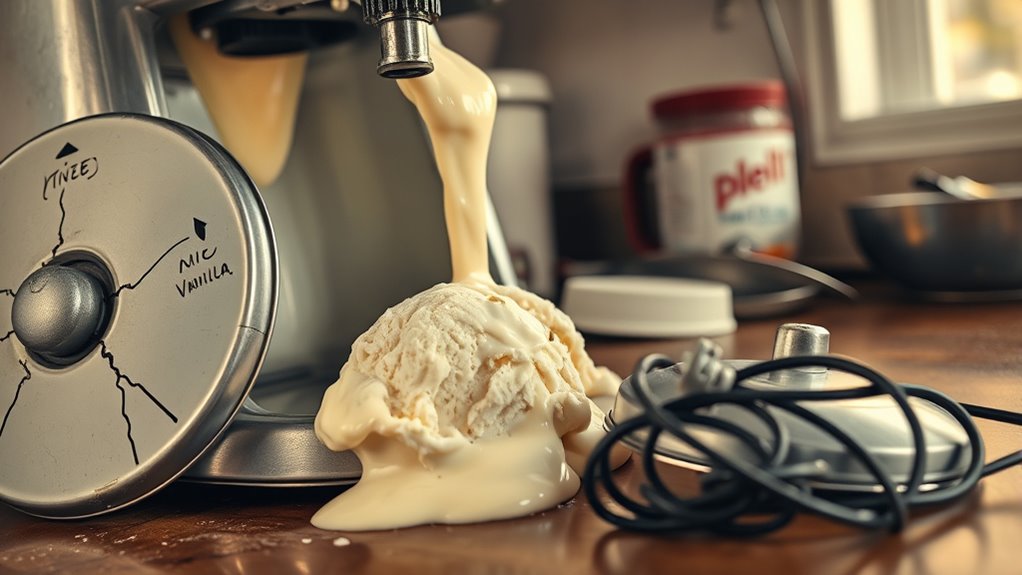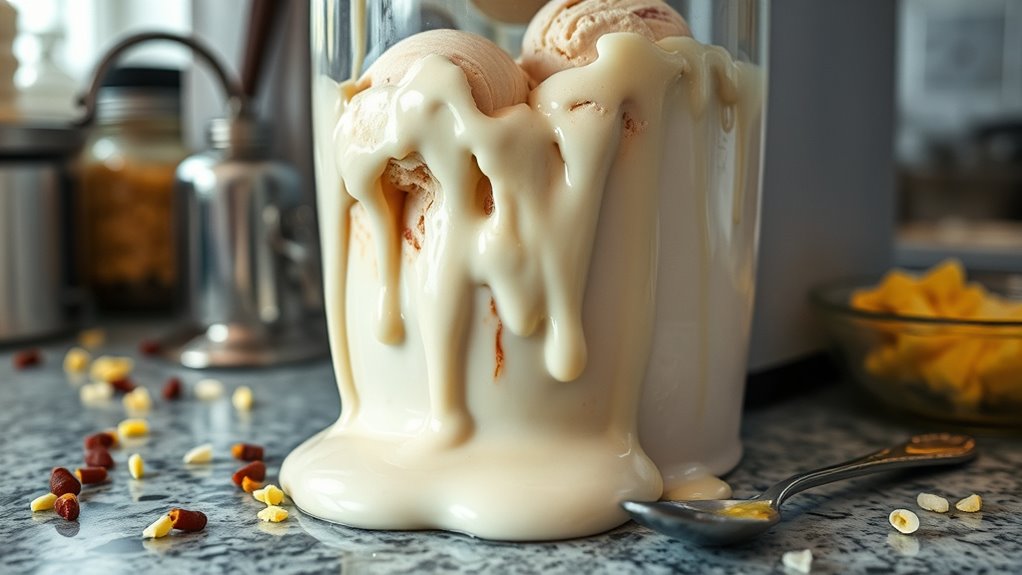If you’re making mistakes with your ice cream machine right now, it’s likely because you’re not freezing the mixture properly or skipping thorough cleaning before use. Avoid rushing the churning process or assembling it incorrectly, as that affects texture and consistency. Regular maintenance and proper cleaning also prevent issues down the line. Stay tuned, because knowing these common errors can help you get perfect ice cream every time.
Key Takeaways
- Not freezing the machine’s bowl or ingredients properly, leading to uneven, grainy ice cream texture.
- Failing to clean all parts thoroughly after each use, risking contamination and spoilage.
- Assembling the machine incorrectly or rushing the churning process, compromising texture and consistency.
- Ignoring regular maintenance checks, which can cause damage and reduce machine lifespan.
- Skipping professional servicing or proper cleaning procedures, resulting in flavor transfer and inconsistent results.

Using your ice cream machine without proper preparation can lead to frustrating mistakes that ruin your treat. One common error is neglecting the correct freezing techniques. Before you even start churning, you need to make certain that your ingredients and the machine are properly chilled. If the mixture isn’t cold enough, you won’t achieve that smooth, creamy texture you’re aiming for. It’s best to refrigerate your base for at least a few hours or overnight, depending on the recipe. Some people skip this step, but it’s vital for proper freezing and consistency. Also, make sure your machine’s bowl or insert is frozen solid—most models require several hours in the freezer beforehand. Failure to do so means the mixture won’t freeze evenly, resulting in a grainy or icy texture instead of silky smooth ice cream.
Another mistake often made is overlooking cleaning tips, which can cause contamination or affect the flavor of your next batch. After each use, you should thoroughly clean all parts that come into contact with the mixture. Use warm water and mild soap, and avoid harsh scrubbing that could damage the surface. Some parts, like the paddle or blade, need special attention to remove residual ice cream or buildup that can harbor bacteria. Proper cleaning prevents mold growth and keeps your machine functioning efficiently. Additionally, drying all components thoroughly before storage helps prevent rust and unpleasant odors. If you leave parts wet or store the machine with leftover ingredients, you risk mold or spoilage that can ruin future batches. Proper machine maintenance ensures longevity and optimal performance. Regular inspections and following the manufacturer’s guidelines can also help you identify potential issues early and ensure the machine operates at peak efficiency.
Another common mistake is not paying attention to the assembly of your machine. Make certain all parts are correctly fitted before turning it on. If the lid or paddle isn’t properly secured, your ice cream might not churn properly, leading to inconsistent results or even damage to the machine. Also, don’t rush the process—many machines have a recommended churning time. Cutting corners might save time, but it can compromise the texture of your ice cream. Patience is key; let the machine do its job without interruption. Ensuring your machine is well-maintained with regular inspections and following the manufacturer’s instructions can prevent unexpected breakdowns and extend its lifespan, especially given that best heat pump systems are designed to operate reliably over many years.
Lastly, avoid ignoring maintenance routines. Regularly check the power cord and switches for damage, and follow the manufacturer’s instructions for parts replacement or troubleshooting. Doing so prolongs your machine’s lifespan and keeps your ice cream tasting as fresh as possible. In brief, paying attention to freezing techniques and cleaning tips, along with proper assembly and maintenance, helps you avoid common mistakes that can turn your homemade ice cream into a disappointing experience. Proper cleaning procedures are essential to prevent lingering residues that affect flavor and texture. Additionally, scheduling periodic professional servicing can help ensure your machine remains in top condition for years to come.
Frequently Asked Questions
How Often Should I Clean My Ice Cream Machine?
You should clean your ice cream machine after every use to maintain quality and safety. Follow a consistent cleaning schedule, ideally daily if used frequently, to prevent bacteria buildup. Use proper sanitation tips, like sanitizing all parts that contact ice cream and guaranteeing thorough rinsing. Regular cleaning not only keeps your machine running smoothly but also ensures your ice cream remains fresh and safe for consumption.
Can I Use Homemade Mix Instead of Store-Bought?
Imagine choosing homemade over store-bought; can your ice cream machine handle mixing homemade ice cream instead? Yes, you can, but it’s crucial to evaluate ingredients and consistency. Homemade mixes often lack stabilizers found in store-bought options, which might strain your machine or affect texture. Always pre-cool your mixture, and make certain it’s smooth and well-mixed to avoid clogging or uneven freezing. Experimenting works, but stay attentive to your machine’s performance.
What’s the Ideal Temperature for Serving Ice Cream?
You want to serve ice cream at the perfect temperature for the best scoop. Aim for about 6°F to 10°F (-14°C to -12°C). This cold range allows your ice cream scoop to glide smoothly, creating a creamy, satisfying treat. Too cold, and it’ll be hard to scoop; too warm, and it’ll melt quickly. Keep it at this ideal serving temperature to enjoy the best texture and flavor every time.
How Do I Fix Ice Cream That’S Too Hard?
If your ice cream’s too hard, try adjusting your freezing techniques to soften it. Place the container in the fridge for 10-15 minutes or warm it slightly with a quick burst of heat, like a warm towel, to improve texture. Stirring the ice cream before serving can also help. These simple steps will make your ice cream easier to scoop and enhance its overall texture.
Is It Okay to Leave My Machine Plugged in Overnight?
Leaving your ice cream machine plugged in overnight isn’t recommended. It can pose electrical safety risks, especially if there’s a power surge or fault. Plus, it wastes energy, increasing your electricity bill. Always unplug your machine when not in use to guarantee safety and reduce unnecessary energy consumption. Taking this simple step helps protect your device and saves you money, while keeping your home safe.
Conclusion
Now that you’re aware of these common mistakes, you can avoid them and get the most out of your ice cream machine. Don’t let small errors spoil your sweet success—think of it as tending a garden; with a little care and attention, your frozen treats will flourish. Keep these tips in mind, stay vigilant, and soon you’ll be serving up creamy, perfect ice cream every time. After all, a little know-how goes a long way!








